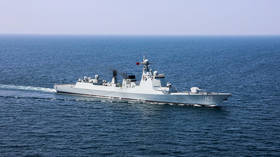China tests weapons for ‘total war’ scenario – media

China has expanded its weapons-testing and evaluation programs to include a global conflict scenario amid rising tensions between Beijing and Washington, the South China Morning Post reported on Wednesday.
According to the article, the latest computer-based wargames and filed tests have been focused on assessing the capabilities of Chinese warships in a doomsday situation.
The so-called ‘Z-war’ scenario “is a clash of strategic willpower. The regional conflict escalates to a total war,” Chinese People’s Liberation Army (PLA) researcher Fang Canxin, whose team carried out the simulation, told the outlet.
Fang’s team declassified its work in a peer-reviewed article published in the Chinese Journal of Ship Research earlier this month. They didn’t identify any specific countries in their paper, but the potential adversaries, who had been designated as the “Blue Alliance,” deployed Arleigh Burke-class destroyers used by the US and its allies, the SCMP wrote.
As part of the simulation, a Chinese destroyer was attacked by more than a dozen missiles and three torpedoes. The Blue Alliance generated jamming noises that were over 30 times stronger than the signal used by the ship to communicate, while also reducing the range of its radars by 60%, according to the article.
In the conditions of such an all-out attack, the destroyer’s combat capabilities were severely reduced. The Chinese vessel lost a third of its air defense potential, while only half of the surface-to-air missiles were able to hit incoming targets, Fang’s team pointed out.
The researchers said that Chinese naval experts had independently assessed the results of their test and found them to be “realistic.”
“It is unlikely that this paper is intended as a horror movie,” an unnamed computer scientist who helped develop commercial war-game software told the newspaper about the work done by Fang’s team.
Researchers often look into worst-case scenarios because it helps them better understand the strengths, weaknesses and limitations of weapons, he explained.
Last week, US Secretary of State Antony Blinken made a long-delayed trip to China in an attempt to defuse mounting tensions between Washington and Beijing over American support for Taiwan, the Chinese balloon incident in February, and other issues.
However, whatever progress Blinken made appears to have been undone by US President Joe Biden, who labeled his Chinese counterpart Xi Jinping a “dictator” just a day after Washington’s top diplomat returned from Beijing. China called the “extremely absurd” comment by Biden “an open political provocation” and summoned the US ambassador for an official reprimand.
Earlier this year, media reports claimed that the head of US Air Mobility Command, General Mike Minihan, stated in a memo that Washington and Beijing could be at war over Taiwan by 2025.













